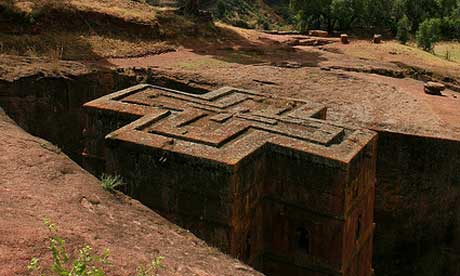
Ethiopia's greatest monument is a work of art and a testament to faith, here we revisit after 30 years
My stomach muscles are sore today. Maybe it was from the mule ride, trying to keep upright down those steep hills, or perhaps it was from trying to emulate the traditional dancers in the tej abet bar yesterday evening.
34 years ago I was much fitter. It had taken me three adventurous days to reach Lalibela on foot, when the countryside was infested with bandits but the local people touchingly hospitable. In 1976 I stayed in a flea-ridden guesthouse with hay on the floor. There was just one tourist hotel; now there are 20.
The tourist infrastructure may have improved but Lalibela’s churches have changed little since the 12th century. Imagine the scene: your king, Lalibela, has had a vision that he must create 14 churches out of the hard basalt rock on which the little town of Roja is built. He’s been shown the design by a helpful angel who promises to assist in the construction. But these churches will not be built up from the ground from bricks or stone, they will be created from the rock itself. Just as Michelangelo cut away all the marble that wasn’t David, so these stone carvers had to remove all the rock that wasn’t a church.
To accomplish this task they had only iron tools and the glory of God. They drew out the basic design – a square, a rectangle or, in one case, a cross – and cut downwards. Helped by a team of angels, they carved the upper storey with windows and the tops of pillars, cutting deeper and deeper, creating a perfectly symmetrical interior with arches and columns, sometimes decorated with elaborate relief carvings of crosses and swirls. They kept going until the church was up to 10m high.
The last, and perhaps the most beautiful church to be hewn was St George’s, carved in the shape of a cross. Legend has it that the patron saint of Ethiopia first demanded that he have his own church and then stayed to supervise the workmen – no doubt with a good complement of angels.
Even if these churches had been abandoned, Lalibela would be an extraordinary place, for what makes a visit here so moving is the devotion of the people. Members of the Ethiopian Coptic Church have been worshipping Christ for longer than any other society and adherence to their faith is as much part of their life as tilling the land.
At dawn on a chilly October morning, I watched the white-swathed figures toiling up the hill to St Gabriel’s church on his saint’s day. They kissed the ground at the entrance of the church, and the pillars, and the large golden cross that the gorgeously-dressed priest held in front of them for the healing ceremony. They lit candles, and gazed at the chanting deacons and drum-beating novices with reverence. Then they returned to their fields.
One theory of how the people of Lalibela were able to accomplish the task of building its churches is that this was always an exceptionally fertile and therefore wealthy part of the country, and to this day the surrounding landscape is as much an attraction as the churches themselves.
Flat-topped, scalloped mountains circle the town, broken by dramatic rocky lumps and towers. So part of my visit to Lalibela was the mule ride to one of the outlying cave churches, Asheton Maryam. With my trusty mule picking his way over the rocks, I was free to observe the villagers going about their daily tasks. The church is simple and rough-hewn, but its location at the foot of one of the highest peaks in the area is sublime. And the treasures that the priest showed us was exceptional: large gold crosses and a richly illustrated parchment bible which is said to date from the time of King Lalibela.
So to the tej abet. Tej is the national drink – honey wine; I love the stuff – so Solomon, the hospitable owner of the Jerusalem Hotel invited me to the Askalech tej abet, where it’s served. In a tiny, dark room decorated with Ethiopian weavings, we watched an energetic woman singer/dancer accompanied by a man playing the masinko, a chunky, one-stringed instrument.
My efforts to imitate her dance were dismal but enjoyable. But I’m sore today.
Hilary sent this story from Lalibela as we went to press in November. She travelled with Rainbow Tours and stayed at Lalibela’s Jerusalem Hotel.